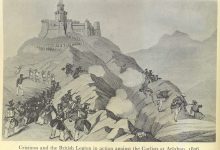The Battle of the Pusan Perimeter (1950): A Pivotal Moment in the Korean War
The Battle of the Pusan Perimeter, fought between August and September 1950, was a decisive turning point in the Korean War, which had erupted just months earlier. This battle marked a critical moment for the United Nations forces, which were primarily composed of American and South Korean troops, as they sought to hold a defensive line around the southeastern tip of the Korean Peninsula, near the city of Pusan. The successful defense of the Pusan Perimeter prevented the complete collapse of the South Korean state and laid the foundation for a counteroffensive that would eventually drive North Korean forces back.
Background
The Korean War began on June 25, 1950, when North Korean forces, under the leadership of Kim Il-sung, launched a surprise invasion of South Korea. The aim of the invasion was to unify the Korean Peninsula under communist rule. Within a few weeks, the North Korean army had pushed the South Korean forces and their allies—chiefly the United States—into a shrinking pocket in the southeastern corner of the peninsula.
By mid-August, the North Korean People’s Army (KPA) had advanced to the southernmost tip of South Korea, threatening to completely overrun the country. However, a series of key battles, the rapid intervention of U.S. forces, and the strategic importance of the port city of Pusan ensured that a defensive stand could be made.
The Perimeter
The Pusan Perimeter was a defensive line that stretched approximately 140 miles (225 km) around the southeastern corner of the Korean Peninsula. The perimeter was anchored on the coastal city of Pusan (now Busan), which held significant logistical value. It was the primary port through which reinforcements, supplies, and equipment were shipped into the region, making its defense critical for the survival of the United Nations (UN) forces.
The UN defense line stretched from the southern coast of Korea near the Sea of Japan (East Sea) to the town of Taegu in the west. It included mountainous terrain, rivers, and the urban defenses of the city of Pusan, which was well-protected by natural barriers. The UN forces faced an overwhelming numerical disadvantage, with over 90,000 North Korean troops encircling them compared to roughly 70,000 American, South Korean, and other UN forces.
Participants
The battle involved a coalition of forces aligned against the communist North Korean army. The primary participants in the battle included:
-
North Korean Forces: The KPA was the main aggressor in the conflict, aiming to subdue South Korea and unify the country under its communist regime. Led by Kim Il-sung, the KPA had experienced initial success due to its superior numbers and equipment, but they faced logistical and strategic challenges as they advanced southward.
-
American Forces: The United States was the principal military power defending South Korea, and they were committed to stopping the spread of communism in the region. The U.S. Army, supported by Navy and Air Force assets, formed the backbone of the UN forces. General Walton Walker led the American forces during the battle.
-
South Korean Forces: The South Korean military, initially overwhelmed by the North Korean invasion, had been pushed into the defense of the Pusan Perimeter. While they were numerically inferior and poorly equipped, their tenacity and resilience played a significant role in the battle.
-
Other UN Forces: In addition to U.S. and South Korean forces, smaller contingents from the United Nations, including forces from the United Kingdom, Canada, and several other nations, participated in the defense of the Pusan Perimeter.
-
Seoul: While not a direct participant, the South Korean capital of Seoul became a symbol of the broader stakes in the battle. Its fall to the North Korean forces earlier in the war highlighted the urgency of the situation for the South Korean government and its allies.
The Battle
The battle for the Pusan Perimeter was a desperate defensive action in which UN forces held their ground despite being surrounded on three sides by a numerically superior enemy. The North Korean forces, having already overrun much of South Korea, were eager to finish the job. They pressed the attack in a series of assaults on the perimeter, hoping to break through and capture the last remaining stronghold of resistance.
Despite their numerical advantage, the North Koreans faced difficulties in maintaining their supply lines and coordinating their attacks. The rugged terrain around Pusan, combined with effective air and naval support from the United States, hampered their progress. As the battle wore on, the morale of the North Korean troops began to deteriorate, while the UN forces, bolstered by reinforcements and improved logistics, began to mount a counteroffensive.
One of the key factors in the success of the UN defense was the effective use of naval and air superiority. American and British naval forces provided crucial support by bombing North Korean positions and ensuring that reinforcements and supplies could reach the defenders through the port of Pusan. Similarly, the U.S. Air Force provided close air support, helping to thwart North Korean attempts to break the perimeter.
Turning Point
By early September 1950, the situation for the North Koreans had become untenable. Despite their initial success in pushing UN forces to the edge of the peninsula, the KPA was now stretched thin, with no clear path forward. The successful defense of the Pusan Perimeter not only preserved the South Korean state but also bought enough time for the UN forces to regroup and prepare for a counteroffensive.
The first major turning point came with the arrival of fresh reinforcements from the United States and other UN member nations. These reinforcements, along with the successes of UN air and naval forces, helped stabilize the situation on the ground. By mid-September, UN forces had begun to push back the North Koreans, regaining lost ground and pushing them northward.
The Incheon Landing
The strategic situation shifted dramatically with the Incheon Landing on September 15, 1950. Led by General Douglas MacArthur, this amphibious assault caught the North Korean forces off guard, and the rapid success of the operation threatened to cut off their retreat and encircle them. The Pusan Perimeter had served its purpose—buying enough time for this critical operation, which led to the recapture of Seoul and eventually turned the tide of the war in favor of the UN forces.
Conclusion
The Battle of the Pusan Perimeter was a significant and decisive engagement in the Korean War. While it resulted in a victory for the United Nations forces, the victory came at a high cost in terms of casualties and resources. For the United States and South Korea, the success of the defense preserved the sovereignty of the South and provided a foothold for the eventual recapture of all South Korean territory.
For the North Koreans, the failure to break through the Pusan Perimeter represented a major setback, and their hopes of a quick victory in the war were dashed. The battle, in many ways, marked the beginning of the end for the North Korean advance, even though the conflict would continue for another three years before reaching an armistice.
The Pusan Perimeter remains one of the most critical moments in the history of the Korean War, illustrating the importance of strategic defense, international cooperation, and the ability to adapt in the face of overwhelming odds. The successful defense of this vital area laid the foundation for the eventual success of the United Nations forces and the preservation of South Korea as a free, democratic nation.


